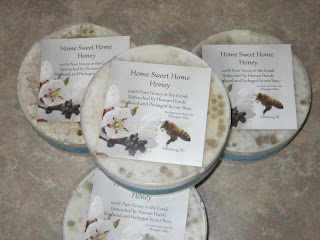 |
| Bee on dandelion |
It’s time to take advantage of these winter doldrums,
especially as we look out at fresh snow (again) in February. While the bees are
busy rubbing their wings for heat and (hopefully) tending the new brood that
will be spring bees, we can curl up by the fire and dream of warmer days. What
better way to do that than with the seed catalogs? We’ve been stock-piling
them since Christmas, so time to jump in and start planning our plantings.
 |
| Bee on hyacinth |
For us, there are two things at the top of the list to
consider – the first is to find plants that feed either the family or the bees,
or both. Because we have locust trees, which create an amazing flavor in honey,
we want to compliment that taste. Raspberries work well, and we have a lot of
them; it’s a good thing because both the bees and the boys love them. We will
be planting some lavender this year, adding to what we already have, and I am
hoping to add more herbs around the new apiary. Crocuses and hyacinth which
bloom in the spring are always good additions (but those are planted in the
fall. We have our crocuses planted in the lawn so they come up and are finished
before the grass needs mowed). Bee balm (monarda), cosmos, Echinacea,
foxgloves, and all blooming trees are a great addition. Asters and zinnia in
the fall are also nice, and goldenrod is another important plant here,
providing nectar and pollen when most plants are shutting down in the heat of
the summer.
 |
| Bee on Cherry Blossom |
The idea of tilling up some of our field to plant it to
clover and wildflowers also has some appeal. It would be a good three-season
food source for the bees, and would cut down on our need to mow the field as
much, reducing our carbon footprint. We will also be experimenting with cover
crops – planting buckwheat on a part of the old pasture to help choke out
invasive weeds and to feed the bees – they love buckwheat (but it does make a
darker honey). We can leave the cuttings on the field at the end of the season,
and that will help improve our soil. We have begun introducing white clover to
our lawns. This is primarily to feed our bees – nothing quite like clover honey
– but also to help keep the areas green in the hot temperatures when lawn just
doesn’t do it without copious amounts of watering, and cuts down the need for
mowing.
 |
| Bee on Apple Blossoms |
This takes us to the second most important consideration; to
choose plants that are hardy and that will not require or come with any chemical
contamination. Along with this, we need plants that can withstand the hot
summers without a lot of water. We have been leaning more toward heirloom
seeds, loving the varieties but also the nostalgia of them. We lean toward West
Coast Seeds from Canada and Johnny’s Seeds in the US, simply because of the
variety and quality – we know what we are getting and that it will be safe for
our bees. We want to grow plants that complement each other, creating a
symbiotic relationship wherever possible to fight diseases and pests. Sometimes
compromises have to be made – marigolds are wonderful for keeping pests away,
but don’t make the nicest honey. Fortunately a little marigold goes a long way
in protecting the garden, and if there are other sources of pollen available
(like raspberries!) the bees will choose those first.
 |
| Bee on buckwheat |
We would be remiss to not mention the vital role dandelions
fill for the bees. In the spring, when there are not a lot of other plants
blooming, dandelions are a godsend. They are a wonderful source of pollen and a
first source of nectar for the bees, keeping them going in a time when the bees
are trying to build hive strength with only a few resources. Please do not
spray your dandelions – they are really only determined but misplaced flowers.
If you find you do have to spray your plants, please avoid
doing it mid-day when the bees are their busiest. In the mornings, when it is
still too cool, or in the evenings, when they are returning home for the day
would be a much better time, if you must. This isn’t just about our bees; it’s
about all the bees and other pollinators depending on these plants for
sustenance.
As an added note from our last blog, we finally have a ‘cleansing
flight’ day for our bees! It’s still colder than what it should be for them to
venture out, but when nature calls…
FLOWERS FOR BEES: Calendula, Butterfly Bush, Cleome, Clarkia, Columbine, Cornflower, Cosmos, Forget-me-not, Delphinium, Dianthus, Digitalis, Echinacea, Blanketflower, Hollyhock, Candytuft (Iberis), Linum, Lavatera, Lobelia, Lunara, Lupins, Morning Glory, Nasturtiums, Purple Tansy, Poppies, Scabiosa, Snapdragons, Statice, Strawflowers, Sunflowers, Veronica, Yarrow, Zinnea
HERBS FOR BEES: Bergamot, Borage, Chamomile, Chives, Lavender, Oregano, Rosemary, Sage, Thyme











































